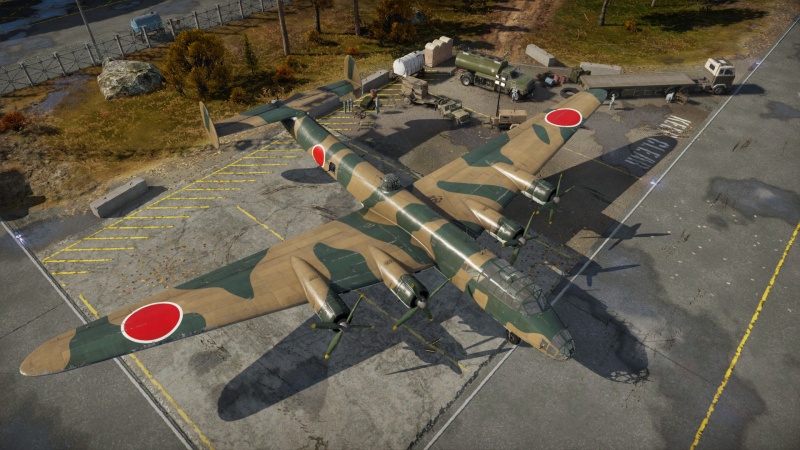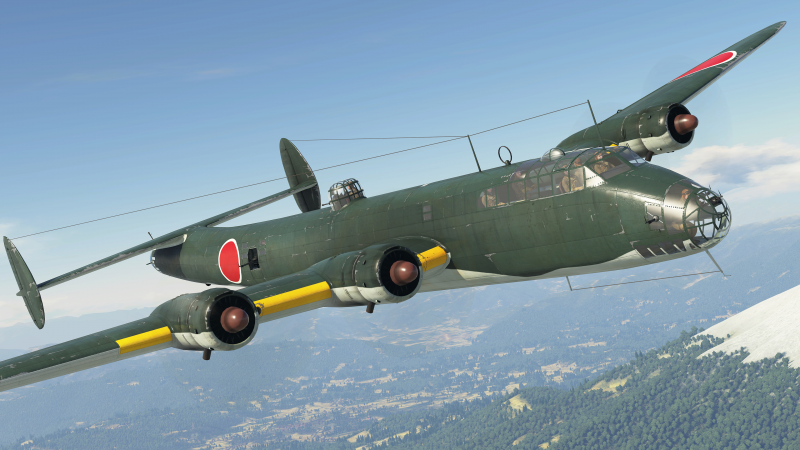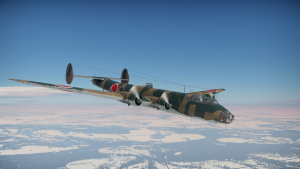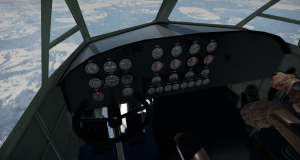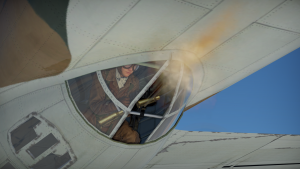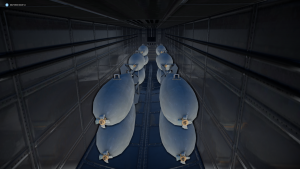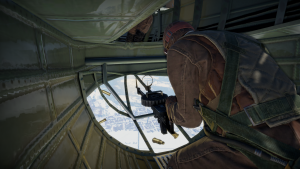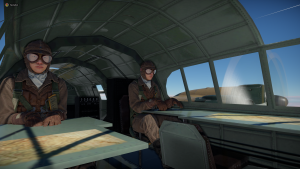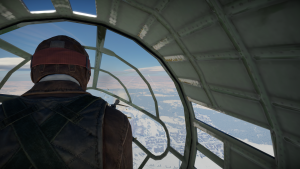G5N1
Contents
Description
The G5N1, designated as Shinzan (深山), was a four-engine heavy bomber developed by Nakajima for the Imperial Japanese Navy before World War II. It was based on the American Douglas DC-4E airliner, which was secretly acquired and reverse-engineered by Japan in 1939. The Shinzan was intended to have a long-range capability of 3,000 nautical miles and a payload capacity of 4,000 kg of bombs or torpedoes. However, the bomber never entered service due to its poor performance, unreliable and underpowered engines.
It was introduced in Update 1.29. The G5N1 serves as one of Japan's true heavy bombers. Featuring a massive airframe and four Mitsubishi MK4B Kasei-12 fourteen-cylinder air-cooled engines, the G5N1 is easily one of the hardest planes to manoeuvre in War Thunder. It makes up for this with its large 3,200 kg payload and its incredible endurance. Since this aircraft is so large and cumbersome, its only true purpose is destroying heavy targets and bases like a true strategic bomber.
- Nicknames
- Official Navy designation: Shinzan (深山, Deep Mountain)
- Allied reporting name: Liz
General info
Flight performance
The G5N1 is quite slow and sluggish, even for a heavy bomber, owning to the fact that it was based on a failed Douglas DC-4E experimental airliner. With a combination of underpowered engines, excessive weight, extremely huge wing surface, and extremely ineffective flaps and ailerons, the G5N1 is slow to accelerate, extremely irresponsive to control inputs (especially at higher speeds), and takes a considerable amount of time and effort just to bank and steer the plane around. Due to this, the G5N1 will occasionally struggle when trying to carpet bombing at vehicle columns or attempting to face your rear gunners at the enemy. Using manual rudder controls are crucial for using this plane, as it helps the plane to turn significantly faster and allows you to turn away from the incoming enemy as soon as possible. As the plane has a low rip speed of just 500 km/h (300 mph), you won't be outrunning anything.
However, owning to its civilian airliner origins, the G5N1 has a very low stall speed of just 160 km/h (90 mph) thanks to its massive wings generating more than enough lift to keep the plane in the air. This gives the G5N1 a unique capability of being able to take off and landing using small airfields, as the plane can get airborne and land quickly using flaps. The aforementioned extra lift can also keep the G5N1 airborne even with multiple engines damaged or disabled and allows the pilot to nurse the plane back to the airfield. The G5N1 also has decent energy retention in a climb and in a shallow dive, which allows it to gain some energy for climbing.
| Characteristics | Max Speed (km/h at 4,000 m) |
Max altitude (metres) |
Turn time (seconds) |
Rate of climb (metres/second) |
Take-off run (metres) | |||
|---|---|---|---|---|---|---|---|---|
| AB | RB | AB | RB | AB | RB | |||
| Stock | 384 | 374 | 28.9 | 29.6 | 3.7 | 3.7 | 650 | |
| Upgraded | 421 | 402 | 27.2 | 28.0 | 9.4 | 6.1 | ||
Details
| Features | ||||
|---|---|---|---|---|
| Combat flaps | Take-off flaps | Landing flaps | Air brakes | Arrestor gear |
| ✓ | ✓ | ✓ | X | X |
| Limits | ||||||
|---|---|---|---|---|---|---|
| Wings (km/h) | Gear (km/h) | Flaps (km/h) | Max Static G | |||
| Combat | Take-off | Landing | + | - | ||
| 363 | 341 | 230 | ~4 | ~3 | ||
| Optimal velocities (km/h) | |||
|---|---|---|---|
| Ailerons | Rudder | Elevators | Radiator |
| < 300 | < 180 | < 270 | > 335 |
Survivability and armour
- Pilot's seat, 13 mm of steel protection
- Copilot's seat, 13 mm of steel protection
In contrast with any other Japanese planes, the G5N1's airframe is incredibly tough. The plane can soak up a large amount of rounds, even capable of taking multiple hits from 20 mm cannons, and with two pilots who sit far away from each other, the plane is less vulnerable to pilot snipe. However, as with any other Japanese planes, the G5N1 is highly volatile and will catch fire very often, without manual engine control, the plane will have little chance to survive fire.
Modifications and economy
Unlike other heavy bombers, the G5N1 can research all of its bomb options right from the start. Unlock all weapons modifications as they will generally improve research point gains as well as survivability.
Armaments
Suspended armament
The G5N1 can be outfitted with the following ordnance:
- 24 x 60 kg Navy Type 97 Number 6 bombs (1,440 kg total)
- 12 x 250 kg Navy Type Number 25 Model 2 bombs (3,000 kg total)
- 4 x 800 kg Number 80 Mod. 1 bombs (3,200 kg total)
Defensive armament
The G5N1 is defended by:
- 1 x 20 mm Type 99 Model 1 cannon, dorsal turret (540 rpg)
- 1 x 20 mm Type 99 Model 1 cannon, tail turret (360 rpg)
- 1 x 7.7 mm Type 97 machine gun, nose turret (679 rpg)
- 1 x 7.7 mm Type 97 machine gun, 2 x cheek turrets (697 rpg)
- 1 x 7.7 mm Type 97 machine gun, ventral turret (679 rpg)
- 1 x 7.7 mm Type 97 machine gun, 2 x beam turrets (582 rpg)
The G5N1 is equipped with several defensive guns: two powerful 20 mm Type 99 cannons mounted on a dorsal and tail turret and 4 x 7.7 mm Type 97 machine guns. The defensive turrets lack armour to protect the gunners: the tail gunner will be usually knocked out before he is able to get the gun on the targets, leaving the plane almost defenceless to attacks from the rear. The defensive armament also has a limited coverage: the dorsal turret cannot fire directly backwards even with the H-shaped tail (because the tail has a small elevation that blocks the firing arc), forcing you to put your nose up to allow it to fire at a chasing enemy. The tail turret is an unconventional swivelling turret that can only elevate the gun upwards, and has to traverse the whole turret vertically to engage any enemy that's not at your six. The dorsal turret also has very poor elevation of just 25 degrees, leaving the G5N1 vulnerable to an attack from above. Finally, the 7.7 mm Type 97 machine guns complementing the 20 mm guns have a poor damage output and won't deter any fighter from attacking.
Usage in battles
If the "14 in mod 35" module isn't researched, the other two bomb options can still be viable. The 24 x 60 kg bomb option can be useful on the map New Guinea because the enemy team has several cargo ships and light cruisers. Both are soft targets, and with 24 bombs it is straightforward to destroy all of them. The map Zhengzhou features dozens of light and heavy pillboxes which are also easy targets for the G5N1. The 12 x 250 kg bomb option works the best here. It is also possible to use the 60 kg bombs but requires a direct hit to destroy a light pillbox. The benefit of the 250 kg bombs is the bomber can destroy pillboxes without direct hits and may occasionally destroy a nearby AAA or artillery piece. In arcade battles, the 4 x 800 kg bomb option is the best for destroying mini bases and the enemy airfield. Utilise the different bomb options depending on what your target is. For light targets like pillboxes and tanks use either the 60 kg or 250 kg bombs, and for heavy targets like bases and airfields use 800 kg bombs.
The G5N1's atrocious manoeuvrability and poor defensive gun arrangement are the main downfalls that makes this aircraft very hard to use. It is incredibly difficult to turn within both Arcade and Realistic battles. The poor turn rate hinders the ability to drop your payload, thus restricting the G5N1 to high-altitude bombing. In addition, despite its incredibly durable airframe, the G5N1 is still vulnerable to all types of enemy fire both because of its sheer size and its poor defensive armament arrangements. The unconventional 20 mm turret in the tail of this aircraft is quite tricky to use, as it can only rotate vertically instead of horizontally, leaving the gunner vulnerable from any incoming shots. If there is an enemy directly behind your plane it is possible to hit them with it but very difficult due to the delay taken for the gunner to rotate his turret. Thus, the G5N1 will usually have to rely on the second 20 mm cannon in the dorsal position along with the host of 7.7 mm machine guns. If you spot an incoming enemy, it is better to turn away from them as soon as possible to face your tail at an enemy, then switch to the gunner mode while the enemy is around 2 km away from you to allow the tail gunner to get the gun onto the target. As the 20 mm cannon has limited ammo per magazine, it is best to fire the guns in short bursts to range the target, and save the ammunition when enemy is at least around 800 m away from you or less.
Conversely, despite slow top speed and low power output, the G5N1 can climb better than most bombers thanks to its massive wings generating extra lift and conserve more energy. By exploiting the plane's lift power, you can climb to a high altitude by accumulating speed in level flight (at least around 340 km/h) before pulling the nose up to around 10 - 15 degrees to quickly climb. As the airspeed is lowered to around 240 - 250 km/h, you can then level the nose down to regain energy and flight speed again. With each "zoom climb", the G5N1 can get 500 m further from the sea level, which allows the plane to easily reach 6,000-7,000 m altitude in a few minutes.
It should be noted that, while you can climb further than other heavy bombers, you will never be the only one high in the sky. The G5N1 will be frequently pitted against American interceptors or the YaK series that can easily catch up with the lumbering plane, thus be careful about these planes and evade them as soon as you can.
As with any bomber, if you're caught alone or off guard, you're as good as dead. Also, having a fighter escort will boost RP gains drastically. Fighter escorts enable this for all game modes. Generally, try to destroy as many targets as possible without wasting bombs. Use the G5N's strengths and attack the most significant target possible, whether that be a mini base, carrier, or air base. Team up with other players and fly in a formation. Flying with others will help defensively as well as offensively since you'll be able to obliterate your target.
In countering a G5N1, one of the best ways to attack is to attack from the front in a head-on attack. A frontal assault may kill both pilots due to lack of protection to shield them from a head-on attack.
Manual Engine Control
| MEC elements | ||||||
|---|---|---|---|---|---|---|
| Mixer | Pitch | Radiator | Supercharger | Turbocharger | ||
| Oil | Water | Type | ||||
| Not controllable | Controllable Auto control available |
Controllable Not auto controlled |
Controllable Not auto controlled |
Separate | Controllable 2 gears |
Not controllable |
Pros and cons
Pros:
- Good 3,200 kg total bomb load with good bomb choice
- Both pilots sit far apart on an armoured seats, making them difficult to snipe except from head-ons
- Huge wings provide extra lift and energy retention, and allow the plane to stay airborne even with multiple damaged/disabled engines
- Surprisingly good climb rate for a heavy bomber owning to its relatively good straight line energy retention for its size
- Very durable, can take a lot of punishments before going down
- Has two reasonably accurate 20 mm guns which can be lethal if they hit the target
- Easy to take off and land due to low stall speed. Capable of using small airfields, unlike other heavy bombers
Cons:
- Massive airframe, easy to target from a distance
- Slow top speed and poor acceleration
- Extremely ineffective flaps and ailerons, inability to manoeuvre reactively and resulting into huge turn radius without using rudders
- Poor overall defensive armament arrangements
- Most of the firing angles were only covered by a weak 7.7 mm guns
- Unconventional tail turret takes a considerable amount of time to aim onto the target, leaving the gunner vulnerable
- Lack of overall armour protection (only on pilot seats)
- Prone to fuel and engine fires when hit
History
This aircraft was designed off of the Douglas DC-4E. It was Japan's first take on a four-engine heavy bomber design, and the DC-4E was first shipped to Japan's Nippon Koku K.K. aircraft corporation. After that, it was sent in secret to the Nakajima Aircraft Company for inspection. Having only six prototypes built, the G5N Shinzan saw no combat. The Allies assuming this aircraft to be a bomber, they utilised the name "Liz".
| Archive of the in-game description | |
|---|---|
|
Nakajima G5N1 "Shinzan" experimental four-engine, long-range, land-based bomber (Allied reporting name: Liz), Navy 13-Shi specification An all-metal, seven-seat cantilever monoplane with retractable nose landing gear. It was designed in 1939-41 in the design bureau of Nakajima Aircraft Company, following the Imperial Japanese Navy's 13-Shi specification. The specification called for a long-range bomber with a flight range of about 3,000-3,500 nautical miles. Since the Japanese aircraft designers at that point lacked experience creating a heavy four-engine aircraft, like the new bomber would be, it was decided to take a foreign design as the basis of the plane, to achieve the required characteristics. For this purpose, the Nippon Koku K.K. airline purchased the sole model of the American Douglas DC-4E airliner that was given in 1939 to the Nakajima Company after arriving in Japan, without making this knowledge public, to create the long-range bomber on its basis. A G5N1 prototype, which became the first four-engine aircraft in the Japanese Navy, got off the ground in April 1941. The plane created by the Japanese designers retained the wing, the powerplant, and the landing gear of its American prototype, but it had a new fuselage with a glazed nose and a bomb bay, as well as a new twin-fin tail. The G5N1 was the first aircraft created in Japan to have a nosewheel. The G5N1 bomber had four Mitsubishi MK4B Kasei-12 fourteen-cylinder air-cooled engines, with a maximum takeoff power of 1,530 hp and Sumitomo/Hamilton four-bladed, fixed-pitch metal propellers. The G5N1 bomber's defensive armament consisted of two 20 mm Type 99 Model 1 (Oerlikon FF) magazine-fed cannons: one in a rear turret, and one in an upper turret, capable of 360-degree fire and electrically driven. The cannon in the upper turret had 12 drum magazines with 45 rounds each for a total of 540 shots, and the rear one had 8 drum magazines with 45 rounds each for a total of 360 shots. Four 7.7 mm Type 97 (Lewis) magazine-fed machine guns were mounted in a nose, a ventral, and two side turrets. The machine guns in the nose and the ventral mounts had 7 pan magazines with 97 rounds each for a total of 679 shots, and those in the side mounts had 6 pan magazines with 97 rounds each for a total of 582 shots. The G5N1 bomber's combat load was only carried internally. Bombs ranging from 60 kg to 1,500 kg, in various combinations, could be suspended in the bomb bay positioned along the whole length of the centre wing section. The maximum bomb capacity was 4,000 kg. A total of 4 G5N1 prototypes were built. | |
Media
- Skins
See also
Similar aircraft:
External links
| Nakajima Aircraft Company (中島飛行機株式会社 ) | |
|---|---|
| Fighters | Ki-27 otsu · Ki-27 otsu Tachiarai |
| Ki-43-I · Ki-43-II · Ki-43-III otsu | |
| Ki-44-I · Ki-44-I 34 · Ki-44-II otsu · Ki-44-II hei | |
| Ki-84 ko · Ki-84 otsu · Ki-84 hei | |
| Ki-87 | |
| Hydroplanes | A6M2-N* |
| Interceptors | J1N1 · J5N1 |
| Bombers | B5N2 |
| B6N1 Model 11 · B6N2 Model 12 · B6N2a Model 12Ko | |
| G5N1 · G8N1 | |
| Ki-49-I · Ki-49-IIa · Ki-49-IIb · Ki-49-IIb/L | |
| Recon | E8N2 |
| Jet Fighters | Kikka |
| Captured | ␗Ki-27 otsu · ▃Ki-43-II · ␗Ki-43-III ko · ␗Ki-44-II hei · ␗Ki-84 ko |
| *Refit of the Mitsubishi A6M2 mod. 11 | |
| See also | Fuji Heavy Industries (1957-2017) |
| Japan bombers | |
|---|---|
| Navy | |
| Carrier-based attack bomber | |
| B5N | B5N2 |
| B6N | B6N1 · B6N2 · B6N2a |
| B7A | B7A2 · B7A2 (Homare 23) |
| Carrier-based dive bomber | |
| D3A | D3A1 |
| D4Y | D4Y1 · D4Y2 · D4Y3 Ko |
| Shipboard Observation seaplane | |
| F1M | F1M2 |
| Land-based Attack bomber | |
| G4M | G4M1 |
| G5N | G5N1 |
| G8N | G8N1 |
| Flying boat | |
| H6K | H6K4 |
| H8K | H8K2 · H8K3 |
| Land-based Bomber | |
| P1Y | P1Y1 |
| Army | |
| Light | Ki-32 |
| Ki-48-II otsu | |
| Heavy | Ki-21-Ia · Ki-21-I hei |
| Ki-49-I · Ki-49-IIa · Ki-49-IIb · Ki-49-IIb/L | |
| Ki-67-I Ko · Ki-67-I otsu | |
| Other countries | ▅B-17E |



